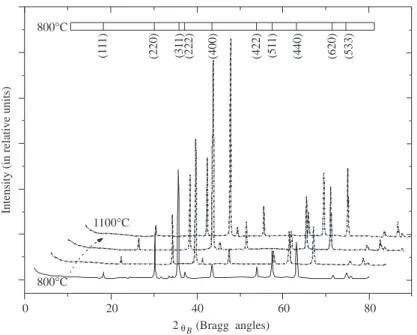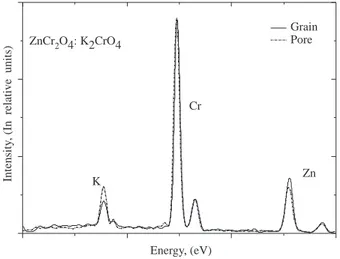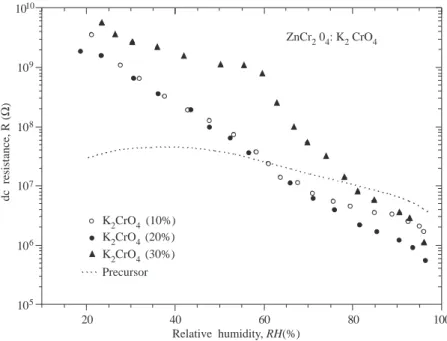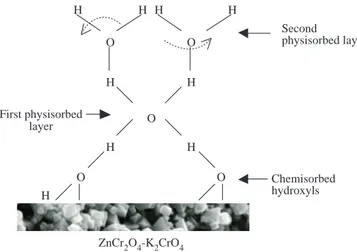c
T ¨UB˙ITAK
Air Moisture Sensing Properties of ZnCr
2
O
4
–K
2
CrO
4
Composites
N. KAVASO ˘GLU and M. BAYHAN
Department of Physics, University of Mu˘gla, K¨otekli, 48000, Mu˘gla-TURKEY
e-mail: nkavaso˘glu@mu.edu.tr, mbayhan@mu.edu.tr
Received 21.02.2005
Abstract
Crystalline structure, surface morphology and the response to air moisture of ceramic system of com-position ZnCr2O4−K2CrO4 formed by solid state reaction at elevated temperatures were investigated.
The fired ceramic body, which proved to be mainly constructed from about 1 µm sized ZnCr2O4spinel
grains, was found to be porous. The humidity sensing behaviour of the sensors reveals that the elec-trical conduction is protonic and is controlled through the thin layers of water adsorbed on the surface of the grains, with charge transfer to the electrodes. Only the material containing 20% K2CrO4 in
ZnCr2O4exhibited an exponential behaviour to humidity, which shows about three orders change in the
dc resistance over the relative humidity (RH) range between 25 and 90%. Based on ac impedance mea-surements, an equivalent circuit associated with a network of RC parallel circuit in series with constant phase elements (CPEs) has been suggested. It can be therefore assumed that such equivalent circuit model of the sensor under moderate moist condition indicates the charge transport processes mediated by proton hopping and diffusion.
1.
Introduction
In recent years, there has been increased demand for physical and chemical sensors, among which gas sensors have witnessed a great amount of scientific and technological application. In particular, humidity sensors have been important for the accurate control and reliable estimate of water vapour content in atmospheres from industrial processes to the general improvement of the quality of life [1–5]. During last two decades, numerous humidity sensors based on different transduction techniques have been studied extensively at both room and elevated temperatures [6–9]. Generally, a humidity sensor has to match stringent working requirements, possess fast response, high sensitivity, negligible hysteresis over periods of usage and, possibly, a large operating range for both humidity and temperature. Since all these issues are not yet fully satisfied by a single commercially available sensor, novel humidity- sensitive materials are being investigated.
The majority of humidity sensors are built from solid electrolytes, organic polymers and porous ceramics, each having its own merits and provide a direct electric signal as a function of atmospheric humidity. Ceramic-type humidity sensors are based on sintered oxides via solid state reactions and are in general possess superior performance to electrolytic and polymeric sensors, due to their high thermal stability with respect to a variety of chemical species, wide range of operating temperatures, fast response to changes in humidity [10, 11] and the ease with which it may be produced in thin film form. However they are, to a certain extent, not fully satisfactory in terms of the need for periodic thermal cycling to recover their humidity-sensitive properties.
In recent years, thin film ceramic sensors possessing nanometer-scale grain size and porous structure have drawn particular interest because of their potential applications in microsensors [12].
Three basic phenomena lie behind the operational principles of both polymeric and ceramic humidity sensors: the formation of a chemically adsorbed layer of hydroxyl ions bonded to metal ions at the grain surface; the successive growth of multiplayer, physisorbed water molecules; and the further condensation of liquid water into capillary pores. Contribution to surface conductance can be expected from both protons hopping between adjacent hydrogen bonded water molecules (via the Grotthus mechanism, [13]) and the electrolysis of the condensed liquid. In addition, reorientation of the molecules in the second physisorbed layer under an applied field produces a variation in the dielectric constant with air moisture.
Ternary oxide ceramics have been shown to exhibit changes in their electrical conductivities with environ-mental moisture. Materials based on zinc chromite, as an example of a ternary metal oxide spinel, have long been identified as a possible active material in chemical sensing applications [14–16]. However, air moisture ceramic sensors based on pure zinc chromite are rather poor in performance. Consequently metal oxides, such as Li2O and TiO2, are added into the main ceramic body as a sintering aid in an attempt to enhance
the humidity response characteristics with a reasonably low resistance, especially in dry environments [17, 18]. We report in the present article an investigation into ZnCr2O4−K2CrO4 composites prepared by solid
state reaction at elevated temperature, operating in the dc mode as humidity sensor. The variation of the dc resistance was studied as a function of relative humidity.
2.
Experimental
Commercially available powders of ZnO and Cr2O3with highest purity were used as precursors. Intimate
mixtures of ZnO:Cr2O3with molar ratios of 2:1 and 1:1 were crushed in an agate pestle and mortar for 30 min,
followed by calcination at temperatures ranging between 800 and 1100◦C with a heating rate of 500◦C·h−1 in a Carbolite RWF12/5 muffle furnace. The composition and the phase were assessed by X-ray diffraction (Shimadzu XRD-600 diffractometer with Cu target and iron-filtered emission, producing a wavelength of 1.5418 ˚A) to monitor the reaction progress and eventually to optimise the sintering temperature. The fine-powdered ZnCr2O4was pressed under a pressure of 1–2 tons cm−2 into pellets 13 mm in diameter and 1–3
mm thickness; the pellets were then fired at a temperate of 1100◦C for about 12 hours. The surface and fractured morphologies and porosity of the pellets were examined by scanning electron microscopy (via a Jeol JXA840A). Elemental species present in the pellets were also analysed using energy dispersive analysis by X-rays (EDX).
The dc resistance as a function of relative humidity measurements were carried out using two point probe technique. For this purpose, a Keithley-236 source and measure unit was used to measure the current and voltage. The samples were initially mounted in a custom built chamber, where the humidity was controlled by passing a carrier gas through water at predetermined rates. The relative humidity in the chamber was monitored using a Testo 625 reference humidity meter. The metallic contacts were made using gallium and/or silver, both of which displayed ohmic behaviour. The potential inaccuracy due to contact resistance could be assumed to be negligible owing to the high resistivity of the materials under investigation. The ac impedance measurements were performed using a Hewlett Packard HP 4192A impedance analyser over the frequency range between 5 Hz–13 MHz, using an excitation signal of < 50 mV amplitude.
3.
Results and Discussions
The 2ZnO:1Cr2O3 powder was observed to have XRD Bragg peaks at 2θB = 30.5◦, 35.9◦, 37.5◦, 43.5◦,
54.0◦, 57.5◦ and 63.2◦, and the peaks are thought to be associated with ZnCr2O4 planes. The 2θB peaks
observed at 34.5◦, 47.7◦, 56.8◦, 68.1◦ and 69.2◦ are associated with corresponding planes of ZnO. Further-more, the peak at 2θB = 31.9◦ is thought to be associated with Cr2O5. The Miller indices and the Bragg
peak ratios determined have been reported elsewhere in detail [19]. These results indicate that, despite the stoichiometric ratio chosen to produce ZnCr2O4, the formation of ZnCr2O4 had not gone to completion,
with the residuals of both ZnO and Cr2O5 evidently being present in the chromite XRD characterizations.
Under XRD, 1ZnO:1Cr2O3was observed to exhibit Bragg peaks at 2θB= 18.43◦, 30.33◦, 35.74◦, 37.38◦,
43.44◦, 53.91◦, 57.47◦, 63.12◦, 71.63◦and 74.70◦, and the peaks are thought to be associated with ZnCr2O4,
implying the formation of a monophase cubic body. Figure 1 shows the XRD data for 1ZnO:1Cr2O3powder.
The lattice constant a0, derived from each diffraction peak was plotted against cos2 θ / sin θ (not shown here)
and the extrapolation of the data to θ = π/2 yielded the lattice constant as 8.3298 ˚A [20].
0 20 40 60 80 (533) (620) (440) (51 1) (422) (31 1) (400) (220) (222) (111 ) 800°C
Intensity (in relative units)
2θB (Bragg angles) 800°C
1100°C
Figure 1. X-ray diffraction patterns of 1ZnO:1Cr2O3 powder obtained after firing in the range of 800–1100◦C for
about 12 hours.
Potassium chromate (K2CrO4) was incorporated as a sintering aid in various percentages (by weight)
to probe the overall air moisture sensitive conductivity of the ceramic body. X-ray diffraction spectra from the samples in which K2CrO4was added by 10%, 20% and 30% by weight indicated that the diffraction
peaks are associated with the corresponding {hkl} planes of Cr3O8, CrO3, Cr2O3, K2Cr2O7, KCrO2 and
K2CrO4. Figure 2 shows the secondary electron micrographs from the as-fired surface of ZnCr2O4:K2CrO4
(20%) sample fired at 1000 ◦C for about 12 hours. The ceramic body was porous in nature with a grain size about 1 µm and a great number of pores, indicative of volatilization of one or more of the components (probably, potassium) at high temperatures. Moreover, EDX scans of grain and grain boundaries revealed that potassium content of grain boundaries was significantly higher as compared to that of the grains (see Figure 3). This was, for instance, more pronounced for the sample containing 30% K2CrO4. These results
suggest the incorporation of potassium atoms in the lattice and the formation of a potassium rich phase as a liquid phase to assist the binding of the grains together which results in higher mechanical strength of the ceramic bodies. The conclusion therefore, is that potassium compounds afford a binding action and act as a good sintering aid.
Figure 4 shows dc resistance as a function of relative humidity of ZnCr2O4:K2CrO4 ceramic system at
various percentages of potassium chromate. The dc resistance was a strong function of the humidity for all compositions, decreasing by several orders of magnitude upon increasing humidity, although only material containing 20% K2CrO4 displayed an exponential behaviour as function of RH. This is broadly consistent
with what is normally reported and is generally understood in terms of through an adsorbed water phase. The extent of ionisation is believed to depend upon the amount of water adsorbed for two reasons: the degree
of hydration of the proton bearing species; and the effect of local dielectric constant on the hydroxyls and water dissociation energies. These two effects operate simultaneously and lead consequently to a variation of resistance with water content. The conduction mechanism concluded from the evidence given above is ionic and that protons are probably the dominant charge carriers [13, 21]. For the sake of an easy and satisfying understanding of electrical conduction taking place in the proton-type ceramic humidity sensors, some essential information is briefly given in Appendix. A least-squares best fit to the values of dc resistance versus relative humidity for the sample containing 20% K2CrO4 yielded log(R) = 10.22− 0.05 (RH) (with
R in ohms and RH in %).
Figure 2. The as-fired surface secondary electron micrograph of ZnCr2O4:K2CrO4 (20%) sample sintered at 1000
◦C for about 12 hours.
Zn Cr
K ZnCr2O4: K2CrO4
Intensity
, (In relative units)
Energy, (eV)
Grain Pore
Figure 3. Typical EDX spectra recorded from the pellet containing 20% K2CrO4followed by a firing at 1000◦C for
about 12 hours.
Copper oxide (CuO) was introduced to some samples containing 20% potassium chromate in attempt to increase the conductivity further, as a low percentage additive. The corresponding dc resistance versus relative humidity characteristics showed that the addition of CuO had a dramatic effect on the humidity dependence (not shown here). The addition of only 1% CuO lowered the resistance at low humidity (RH <∼ 40%) by approximately an order of magnitude, while at higher humidity it appeared to have no effect. Increasing the level of CuO doping not only further reduced the low humidity resistance, it reversed the slope of the characteristic, so that for RH <∼ 40% resistance increased with increasing humidity. The physical origin of this reversal of slope is not at present clearly understood.
20 40 60 80 100 105 106 107 108 109 1010 dc resistance, R ( Ω ) Relative humidity, RH(%) Precursor ZnCr2 04: K2 CrO4 K2CrO4 (10%) K2CrO4 (20%) K2CrO4 (30%)
Figure 4. dc resistance versus relative humidity characteristic of the ZnCr2O4:K2CrO4 ceramic system at various
percentages of potassium chromate.
The Cole-Cole plot of complex impedance (see Figure 5) of the sample containing 20% K2CrO4 in a
moderate ambient humidity (RH = 33%) consists of a depressed semicircle and a straight line at an angle of
∼45◦to the real axis. The semicircle corresponds to a parallel combination of a dc conductance and a slightly
dispersive capacitance together with a so-called pseudo-inductance loop [22]. The conductance accompanies to the principle charge transport process in the sample, and the capacitance representing geometrical and artifactual capacitances of the measurement combined with modifications caused by the dielectric nature of the absorbed water. Diffusion of the ionic species through the interfacial layers formed at the electrodes and at the layers of water molecules as well as inside the filled pores gives rise to a straight line at low frequencies, observed in Figure 5. Therefore, it is proposed that the observed behaviour of this type of material in a moderate humid ambient can be explained in terms of the adsorption of water onto the grain surfaces, and subsequent condensation into pores.
2x103 3x103 4x103 5x103 6x103 0 1x103 2x103 3x103 RH: 33% Imaginary Z (Ohm) Real Z (Ohm) ZnCr2O4: K2CrO4 (20%)
4.
Conclusion
Monophase cubic ZnCr2O4 could be produced from the solid state reaction between zinc oxide and
chromite oxide at elevated temperatures. The fired ceramic bodies, which proved to be mainly constructed from ZnCr2O4 spinel grains, were porous. The dc resistance as a function of relative humidity showed a
strong dependence, decreasing over several orders of magnitude with increasing humidity being a smooth exponential in the case of the sample prepared using K2CrO4 (20%) in ZnCr2O4. The addition of CuO
resulted in an increase in the conductivity but had a deleterious effect upon the humidity. These results indicate that ZnCr2O4−K2CrO4 system once calcined, compacted and sintered under proper conditions has
potential use as an active material in humidity sensors. A network of parallel resistor and capacitor in series with constant phase elements (CPEs) is suggested for an ac equivalent circuit. Such an equivalent circuit model of the sensor under the moderate moist conditions exhibits ion hopping and diffusion processes.
Acknowledgements
The authors would like to acknowledge financial support by the University of Mu˘gla, Research Project Foundation (AFP 97/4). They are grateful to A.W. Brinkman for helpful suggestions and discussions. Thanks are also due to S¸. Oktik for his continuous support of this work. They further thank to E. G¨unay for X-ray diffraction data assessments and to O. Kele¸s for technical assistance in the preparation of the samples.
References
[1] N. Yamazoe and Y. Shimizu, Sen. Actuators, 10, (1986), 379.
[2] H. Arai and T. Seiyama, Sensors: A Comprehensive Survey, ed. W. Gopel, J. Hesse and J. N. Zemel, vol. 3 (VCH, Weinheim, 1992) p. 981.
[3] G.J.C. Verdijck, H.A. Preisig and G. van Straten, J. of Process Control, 15, (2005), 235. [4] C. Laville, J. Y. Deletage and C. Pellet, Sens. Actuators B, 76, (2001), 304.
[5] C. Chen, Biosystems Eng., 88 (2), (2004), 231.
[6] Y. Sakai, M. Matsuguchi and T. Hurukawa, Sens. Actuators B, 66, (2000), 135. [7] Lei Gu, Qing-An Huang and Ming Qin, Sens. Actuators B, 99, (2004), 491. [8] Y. Ren, P. Mormile, L. Petti and G.H. Cross, Sens. Actuators B, 75, (2001), 76. [9] F. P. Delannoy, B. Sorli and A. Boyer, Sens. Actuators A, 84, (2000), 285.
[10] I. C. Cosentino, E.N.S. Muccillo and R. Muccillo, Sens. and Actuators B, 96, (2003), 677.
[11] M. Viviani, M.T. Buscaglia, V. Buscaglia, M. Leoni and P. Nanni, J. of Eur. Ceram. Soc., 21, (2001), 1981. [12] W. P. Tai and J. H Oh, Thin Solid Films, 422, (2002), 220.
[13] G. Toshko, P. Nenov, D. Stefcho and P. Yordanov, “Ceramic Sensors Technology and Applications” (Technomic Publishing Company, Pennsylavania, 1996) p. 87.
[14] Y. Yokomizo, S. Uno, M. Harata and H. Hiraki, Sens. Actuators, 4, (1983), 599. [15] Wu Ming-Tang, Sun Hong-Tao and Li Ping, Sens. Actuators B, 17, (1994), 9.
[17] T. Y. Kim, D. H. Lee, Y. C. Shim, J.U. Bu and S.T. Kim, Sens. Actuators B, 9, (1992), 221. [18] L. J. Golonka, B. W. Licznerski, K. Nitsch and H. Teterycz, Meas. Sci. Technol., 8, (1997), 92. [19] N. Kavaso˘glu, M.Sc. Thesis, Department of Physics, University of Mu˘gla, Turkey, 2001. [20] JCPDS (International Centre of Diffraction Data), Card No: 22−1107, (1996). [21] E. McCafferty and A. C. Zettlemoyer, Discuss. Faraday Soc., 52, (1971), 239–263. [22] Y. C. Yeh, and T. Y. Tseng, J. Mater. Sci., 24, (1989), 2739.
[23] J. Wang, Q. Lin, R. Zhou and B. Xu, Sens. Actuators B, 81, (2002), 248.
APPENDIX
The electrical conduction in proton-type ceramic humidity sensors is basically explained by adsorbed water on the metal oxide surface and also on the capillary water condensation within the pores. At the initial stage of adsorption, the negatively charged oxygen is electrostatically attached to the positively charged metallic ions of the sensor material to form hydroxides. Thus the grain surfaces which are contiguous to the pores are covered by a chemisorbed monolayer. As relative humidity increases first physisorbed layer, localized by hydrogen bonding of a single water molecule to two surface hydroxyls is set up. A hydroxonium group, H3O+is thereafter formed through that molecules in the second layer which are on the average singly
hydrogen bonded to the underlying layer (see Figure 6). Formally, the process is represented by the reaction 2H2O → H3O+ + OH− (A1)
Under the influence of the water, hydronium dissociates
H3O+ → H2O + H+ (A2)
and a proton is released to neighboring water molecules which accepts it while releasing another proton and so on (Grotthus chain reaction). This proton moves freely along the water layer and thus determines the sensor conductivity. At high levels of humidity, liquid water condenses in the pores, according to Kelvin’s law, and electrolytic conduction occurs simultaneously with protonic transport.
O H H Chemisorbed hydroxyls First physisorbed layer Second physisorbed layer ZnCr2O4-K2CrO4 H H O O H H H O O H H



